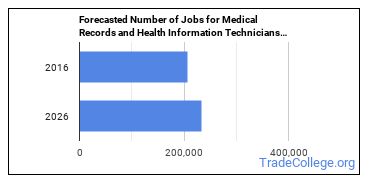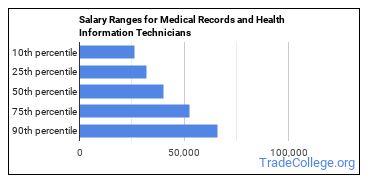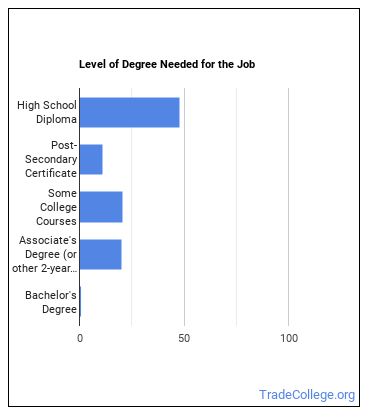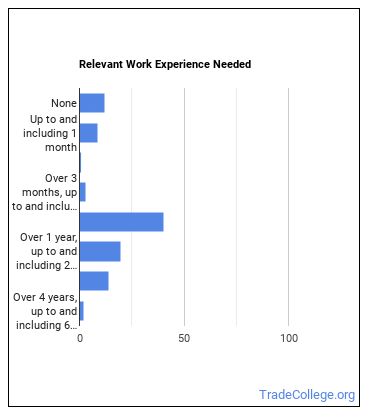Find Trade Colleges
All About Medical Records and Health Information Technicians
Medical Records or Health Information Tech Example Compile, process, and maintain medical records of hospital and clinic patients in a manner consistent with medical, administrative, ethical, legal, and regulatory requirements of the health care system. Process, maintain, compile, and report patient information for health requirements and standards in a manner consistent with the healthcare industry’s numerical coding system.
Life As a Medical Records or Health Information Tech
- Review records for completeness, accuracy, and compliance with regulations.
- Retrieve patient medical records for physicians, technicians, or other medical personnel.
- Consult classification manuals to locate information about disease processes.
- Compile and maintain patients’ medical records to document condition and treatment and to provide data for research or cost control and care improvement efforts.
- Transcribe medical reports.
- Process patient admission or discharge documents.
Featured schools near , edit
What a Medical Records or Health Information Tech Should Know
Below is a list of the skills most Medical Records and Health Information Technicians say are important on the job.
Reading Comprehension: Understanding written sentences and paragraphs in work related documents.
Active Listening: Giving full attention to what other people are saying, taking time to understand the points being made, asking questions as appropriate, and not interrupting at inappropriate times.
Writing: Communicating effectively in writing as appropriate for the needs of the audience.
Speaking: Talking to others to convey information effectively.
Critical Thinking: Using logic and reasoning to identify the strengths and weaknesses of alternative solutions, conclusions or approaches to problems.
Judgment and Decision Making: Considering the relative costs and benefits of potential actions to choose the most appropriate one.
Types of Medical Records or Health Information Tech Jobs
- Medical Reimbursement Specialist
- Medical Claims Processor
- Certified Medical Coder
- Clinical Documentation Improvement Specialist (CDIS)
- Medical Administrative Technician
Medical Records or Health Information Tech Employment Estimates
There were about 206,300 jobs for Medical Records or Health Information Technician in 2016 (in the United States). New jobs are being produced at a rate of 13.5% which is above the national average. The Bureau of Labor Statistics predicts 27,800 new jobs for Medical Records or Health Information Technician by 2026. There will be an estimated 15,800 positions for Medical Records or Health Information Tech per year.

The states with the most job growth for Medical Records or Health Information Tech are Arizona, Utah, and Colorado. Watch out if you plan on working in Rhode Island, Illinois, or Mississippi. These states have the worst job growth for this type of profession.
Medical Records or Health Information Tech Average Salary
The average yearly salary of a Medical Records or Health Information Tech ranges between $26,550 and $66,260.

Medical Records and Health Information Technicians who work in New Jersey, District of Columbia, or Connecticut, make the highest salaries.
Below is a list of the median annual salaries for Medical Records and Health Information Technicians in different U.S. states.
| State | Annual Mean Salary |
|---|---|
| Alabama | $36,470 |
| Alaska | $50,250 |
| Arizona | $40,800 |
| Arkansas | $34,610 |
| California | $51,880 |
| Colorado | $49,340 |
| Connecticut | $51,400 |
| Delaware | $45,390 |
| District of Columbia | $53,430 |
| Florida | $41,340 |
| Georgia | $39,080 |
| Hawaii | $50,940 |
| Idaho | $39,400 |
| Illinois | $45,800 |
| Indiana | $42,350 |
| Iowa | $41,190 |
| Kansas | $39,070 |
| Kentucky | $38,130 |
| Louisiana | $37,430 |
| Maine | $39,030 |
| Maryland | $50,460 |
| Massachusetts | $50,740 |
| Michigan | $41,100 |
| Minnesota | $50,060 |
| Mississippi | $35,300 |
| Missouri | $42,460 |
| Montana | $39,500 |
| Nebraska | $40,430 |
| Nevada | $43,100 |
| New Hampshire | $43,120 |
| New Jersey | $54,020 |
| New Mexico | $38,520 |
| New York | $47,420 |
| North Carolina | $39,740 |
| North Dakota | $43,380 |
| Ohio | $43,980 |
| Oklahoma | $38,140 |
| Oregon | $48,390 |
| Pennsylvania | $41,320 |
| Rhode Island | $47,990 |
| South Carolina | $41,040 |
| South Dakota | $40,170 |
| Tennessee | $43,050 |
| Texas | $41,950 |
| Utah | $42,150 |
| Vermont | $42,480 |
| Virginia | $43,590 |
| Washington | $46,160 |
| West Virginia | $39,430 |
| Wisconsin | $41,810 |
| Wyoming | $42,090 |
What Tools & Technology do Medical Records and Health Information Technicians Use?
Below is a list of the types of tools and technologies that Medical Records and Health Information Technicians may use on a daily basis:
- Microsoft Excel
- Microsoft Word
- Microsoft Office
- Microsoft PowerPoint
- Microsoft Outlook
- Web browser software
- Microsoft Access
- Data entry software
- Email software
- Word processing software
- Microsoft Windows
- Microsoft Project
- Microsoft Visio
- Structured query language SQL
- Microsoft Dynamics
- SAS
- Microsoft Visual Basic
- IBM SPSS Statistics
- Microsoft SQL Server
- R
Becoming a Medical Records or Health Information Tech
Are there Medical Records and Health Information Technicians education requirements?

How many years of work experience do I need?

Related Careers
Those thinking about becoming a Medical Records or Health Information Technician might also be interested in the following careers:
Career changers with experience as a Medical Records or Health Information Technician sometimes find work in one of the following fields:
References:
Image Credit: Staff Sgt. Jerilyn Quintanilla via Public domain
More about our data sources and methodologies.
